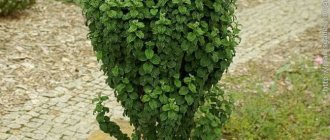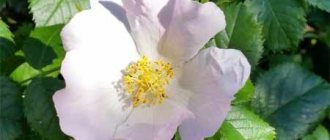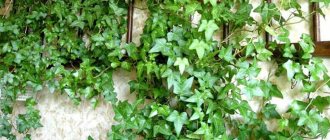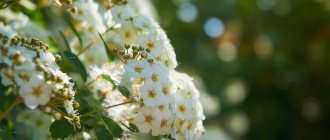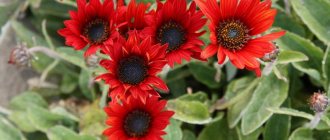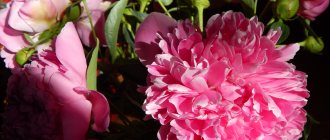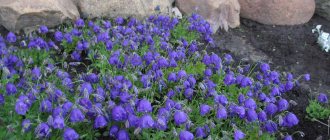general description
Derain (Cornus), or svidina, is a genus of decorative deciduous shrubs of the dogwood family; it unites several dozen species (both deciduous and evergreen), most of which grow in temperate latitudes of the Northern Hemisphere. This genus of shrubs is distinguished by its absolute undemanding conditions and excellent frost resistance. And in addition, they are very decorative, all year round. In spring and summer, derain pleases us with its beautiful foliage (especially variegated varieties) and cute flowers. In autumn, the foliage becomes especially bright and amazing fruits ripen in white, black, blue or reddish shades. In winter, it will also not get lost in the garden, because the bark of its shoots can have rich green, yellow, red and coral colors.
Derain is a shrub with strong and hard wood, which is how it got its name (translated from Latin as “horn”).
Several species of this plant are used in ornamental gardening.
It will be useful to read:
Growing willow spirea Shrubs have a special place in landscape design - they maintain a balance between woody and herbaceous...
Diseases and pests
An adult plant has good immunity and gets sick extremely rarely. With high humidity and thickening, perennials can develop fungal diseases - powdery mildew or gray mold. When the first signs of disease are detected, the turf should be treated with Bordeaux mixture. Chemical preparations “Vector” and “Hom” will also help cope with these diseases. In the fight against uninvited guests - aphids and scale insects - tobacco decoction, infusion of yarrow or potato tops will help. If there is a large infestation, chemicals such as Karbofos will be required.
Derain white
The most common in our region is white dogwood (Cornus alba). It is a deciduous shrub growing up to three meters. Its upward-pointing straight branches have a reddish color of various shades. Young shoots often have a slight bluish coating. The green leaves are oval-shaped, pointed upward, slightly wrinkled. May have a whitish edge. The length of the leaf plate is about ten centimeters. It blooms twice a year: the first time in early summer, and the second in the first half of autumn. Small white or slightly pink flowers are united in a corymb inflorescence. At the end of summer, inedible round fruits, drupes, blue-white or yellowish in color, ripen.
White dogwood is represented in ornamental gardening in many varieties. Let's pay attention to just a few of them.
- Spaethii is a very common species; it has a golden-yellow border along the edge of the leaf in combination with the same spots and stripes. In autumn the foliage turns purple. The shoots are red-brown. Doesn't bloom.
White dogwood “Shpeta”
- Aurea (Aurea) , or Golden , - with yellow and yellow-green foliage and red shoots. Winter hardiness is average.
- Elegantissima is the most frost-resistant, distinguished by a bright and wide white border, as well as red branches.
White Derain "Elegantissima"
- Gauchaultii - low (up to 1.5 m), has edged leaves with pink and yellowish-white spots.
- Siberian or Sibirica (Sibirica) - the height of the bush is one and a half meters, it has a very beautiful red tint of the branches. The leaves are green, turning yellow and red in autumn.
- Sibirica Variegata - variegated form (up to 2 m), foliage with a white border and spots; in autumn the green part of the leaf becomes brownish-purple. The shoots are bright red.
White dogwood "Sibirika variegata"
- Argenteo-marginata - leaves are distinguished by a grayish-white, as if silvery, border, shoots are dark burgundy in color.
White Derain "Kesselring"
- Kesselringii is an unusually beautiful chameleon bush. The leaves are purple-brown when they bloom, then turn greenish-brown and turn bronze in autumn. The fruits are white and the shoots are black and red.
- Cream Cracker is one of the new varieties, low (about 1 m), with red shoots, the leaves have a yellowish border, which gradually becomes creamy.
There are many other varieties of white turf, all of which are distinguished by good frost resistance. Representatives of this species bloom after two years of life.
What lighting is needed
The more brightly and variegated the foliage is, the more light the variety needs to develop. Solid green leaves need less bright lighting. Varietal decorative turf develops better in open areas, and ordinary turf develops better in partial shade. Thanks to this property, white turf adorns street alleys; it is used in areas of high-rise buildings, where lighting is not so active, and shadow or partial shade predominate.
Red derain, or blood-red svidina
Another species is red dogwood (Cornus sanguinea). Slightly less common in gardens than white derain. Flexible green shoots acquire a red tint over time. The pointed, ovate leaves are covered with villi. Dark green in summer, they glow in all shades of red in autumn. Thanks to the autumn color of the leaves, the species got its name. Blooms in the seventh year at the end of spring. Small white flowers are collected in inflorescences-corymbs. Sometimes re-blooming occurs. In August, black round inedible fruits ripen.
Red dogwood is also an unpretentious species, quite frost-resistant, but in very severe winters it can freeze a little.
It has decorative forms and varieties:
- Compressa (Cornus sanguinea Compressa) is a very interesting shrub with compressed, rounded leaves. The foliage is dark green in summer, turning red in autumn. The crown is dense, vertical, about 1 m high. The bark on the branches is reddish-brown. Doesn't bloom.
Red Derain "Compress"
- Winter Beauty (Cornus sanguinea Winter Beauty) is the owner of a round, spreading bush (about 2 m). The shoots are orange-yellow. The leaves are oval, pointed upward. Dark green in summer and red in autumn.
Red Derain "Winter Beauty"
- Midwinter Fire (Cornus sanguinea Midwinter Fire) is a spreading shrub up to one and a half meters, the shoots are bright red-orange. The leaves are rich green in summer, changing color from yellow-orange to dark red in autumn.
- Variegata (Cornus sanguinea Variegata) is a variety with variegated leaves, they have yellow-white spots and a border on a green background, then the leaves turn red. Young shoots are green, but gradually acquire a burgundy hue.
Let us also note some more decorative forms:
- Atro-sanguinea - with deep purple branches.
- Viridissima - distinguished by bright green fruits and shoots.
- Mietschii - young twigs and leaves of an unusual light yellow color.
The varieties of blood-red sow we considered, like the white sod, are frost-resistant.
How derain is used in dachas
In small gardens and summer cottages, the turf looks compact and very picturesque, since its growth can be limited by cuttings. High decorativeness enhances the visual effect. Bushes and trees practically do not get sick and tolerate any weather well.
Read also: Smart garden planning
White turf is planted in compositions with conifers, tall grasses, and creeping low-growing perennials. Variegated varieties look very beautiful on roadside benches, in alpine hills above ponds. Popular use in hedges. Trimming gives greater density to the bushes, which tolerate garden shears well. Large leaves look rich and act as natural scenes. With their help, you can divide your garden plot into zones.
Derain with variegated and colored foliage looks impressive in “solo” plantings. The background is often a bright green lawn, mulch, crushed stone, thickets of periwinkle, ivy, tenacious, alyssum or other low-growing creeping varieties.
Derain kouza, or Japanese dogwood
This species, unlike such as white dogwood and blood-red dogwood, is a tall, beautifully flowering shrub, or even a tree, and can reach a height of 9 m. The homeland of cornus kousa is Japan (also found in the wild of China and Korea).
The crown is wide-spreading, old branches descend strictly horizontally and form tiers. The leaves are oval, pointed at the top. The foliage is dark green in summer (with a bluish tint below), and with the onset of autumn their palette diverges from golden yellow to dark crimson. Flowering begins in June. The flower is a simple yellow-green head, collected from small flowers, around which bracts-involucre leaves (bractea) are located. It is the bractae (up to 9 cm) that make the flowers beautiful, as they have an interesting shape and color. At the end of August, the drupes ripen. They are pink in color and slightly round in shape, similar to strawberries (about 2 cm). The fruits are edible.
Decorative varieties:
- Satomi has rose-red bracts;
Derain kouza "Satomi"
- Gold Star is distinguished by a yellow pattern in the middle of the leaf;
Deren kouza "Gold Star"
- Milky Way has high yields and creamy bracts;
Derain kouza “Milky Way”
- Schmetterling is a profusely flowering variety with white bracts.
This species is considered an “aristocrat” and the most beautiful among its fellows. But, unfortunately, it is less resistant to our winters.
Is derain “friendly” with other plants?
Yes, it is used both in group and individual plantings. The colorful leaves of the tree look great among coniferous and deciduous trees. Designers use it as a backdrop for annuals and perennials. In winter, the bright bark of the pigweed immediately stands out against the backdrop of the snow-white landscape.
This plant does not interfere with the development of others. The foliage does not create an uncomfortable shadow, so the turf can be planted tightly. Form it on a trunk; even low-growing varieties of roses and other flowers grow magnificently under it.
Blooming derain
This species came to us from North America and is a deciduous tree with a spreading crown. Flowering dogwood (Cornus florida) is famous for its abundant flowering, which occurs even before the leaves appear. The flowers are inconspicuous, small, collected in a small head. Their beauty lies in the large bracts, which come in different shades. It is these modified leaves in the spring that turn the flowers into large stars and attract the attention of others.
In the summer, the leaves of this type of tree are simply green, but in the fall, like its fellows, it does not give up its position and colors the foliage in bright yellow, orange and red tones.
This species also has decorative varieties, differing mainly in the color of the bracts.
- Rubra is the most popular of these and the bracts can be colored from light pink to deep red.
Blooming dogwood "Rubra"
- Cherokee Princess - has snow-white bracts.
- Cherokee Chief - captivates with dark pink bractae.
Blooming dogwood "Cherokee Chief"
Although this species can withstand frosts of more than 20 degrees, it is not as winter-hardy as white dogwood and can freeze slightly.
Reviews about Shpeta village
Oksana Zadorozhnaya, 27 years old, Belgorod
I planted Shpet's derain on the designer's advice and am very pleased with the shrub. It looks great and does not lose its decorative qualities even in late autumn. Combines well with other trees on the site. The shrub has been growing for 5 years, I tried curly pruning, but not very well, perhaps it’s better in the standard version. She rarely gets sick, but I always do preventive treatments.
Kremin Olga, 49 years old, Volgograd
I grow the Shpet shrub at the dacha. I really like its bright foliage, which remains beautiful until frost. The plant is unpretentious, does not require special care, and propagates well by cuttings. The shoots quickly take root, the new bush grows quickly. I did not notice any diseases in this plant.
Ekaterina Proklantyeva, 37 years old, Voronezh
The Shpet variety is winter-hardy, rarely gets sick and develops quickly. Planted in a bright place, in the shade the foliage is not so beautiful. The shrub is unpretentious and does not require frequent watering. I’m rarely at the dacha, so there’s no way to fully care for him.
Male dogwood, or common dogwood
Male dogwood (Cornus mas) is well known to all of us under the name “dogwood”. It is widespread in Russia (European part), Ukraine, Moldova, the Caucasus, Western Europe and even the Middle East. In natural conditions it can grow up to 9 meters and live up to 250 years.
Male dogwood, or common dogwood
For most of us, this shrub is associated with red, sweet and sour, slightly pear-shaped drupes. And also with the most delicious jam made from them. However, dogwood is also used as an ornamental plant.
Its shoots are ribbed grayish-brown (young ones are yellow-green). The leaves are oval, pointed upward, covered with small hairs, rich green in color. It blooms in spring, even before the leaves appear, with yellow flowers collected in numerous umbrella inflorescences. The fruits ripen by the end of August. They are not only tasty, but also have medicinal properties.
Male dogwood, or dogwood (fruit)
It is quite winter-hardy, and with partial freezing it grows quickly.
There are many dogwood varieties that are aimed at increasing productivity and fruit quality. However, there are also decorative varieties. For example, Aurea has yellow leaves, Elegantissima is a variegated variety with a wide yellow border, and Variegata has a white border.
In addition to the above species, you can also name the dwarf creeping Canadian dogwood (Cornus canadensis), but it is not frost-resistant, as well as the shoot or silky dogwood (Cornus stolonifera), which is very similar to the white dogwood, only it produces abundant growth.
It will be useful to read:
Barberry in landscape garden design Barberry is a fairly common shrub. Its widespread use in landscape design is due to the presence…
Possible problems in growing turf
The bush may develop a fungus. The leaves will begin to turn brown and black, then fall off. Sometimes local brown spots may appear on the stems of the bush. If you don't pay attention to them, the branch will completely dry out and die. This problem occurs due to excessive watering or watering with cold water. Watering water should be slightly cool and not hard. The fungus can be cured by treating the turf with a solution of Bordeaux mixture or special preparations, such as Vectra or Fundazol.
High humidity and excessive shading of the area provoke the appearance of powdery mildew. It looks like a powdery coating on the leaf blades. Soon the leaves turn yellow, curl and eventually fall off. They get rid of it with special drugs.
If the leaves suddenly dry out and turn yellow right up to the central vein, then the bush has received sunburn. A transplant to a more favorable and shaded place is necessary.
Note! Derain has a specific smell that repels pests.
With its unusual variegated leaf colors, derain has gained immense popularity in landscape design. Simple care, along with a beautiful appearance, is attracting more and more attention to the turf around the world.
Planting derain
So, you have decided to plant turf on your property. It is better to do this in early spring. Although the species we have considered are very unpretentious, you should pay attention to some features.
Let's start choosing a location. Do not forget that these are quite tall shrubs, so consider the distance between the plants themselves, as well as to the walls of buildings and other garden objects. They are not particularly demanding of lighting, but in direct sunlight in the hot summer they can get burned. Therefore, the ideal place for them would be partial shade. Sunny locations are suitable for variegated varieties.
The soil is preferably neutral or slightly acidic, and always loose. Sand should be added to heavy clay soil.
We prepare a small hole (30-50 cm), since the roots of the derains are superficial. We arrange drainage. These plants like slightly moist soil and can tolerate slight drought, but stagnant water is harmful to them. There is no need to apply fertilizer; it is enough to prepare a nutritious soil mixture by adding humus and compost. After planting, water thoroughly and be sure to mulch the root circle.
Using shrubs in landscape design
Hardy, fast-growing turf is indispensable in both urban and garden landscapes:
- it gets along well with coniferous and flower crops, any composition with it will be inimitable;
- responds favorably to a haircut: geometric shapes and images of animals in parks captivate the eye;
- turf planted along benches and gazebos protects from wind and scorching sun;
- In autumn, the derain brings bright colors to a dull landscape, in winter it enlivens a snow-covered park or garden;
- perennial shrubs are planted to strengthen ravines and coastal zones;
- create hedges.
Do you want to make your garden or plot of land bright and original? Then don't forget about the turf. The perennial crop will fill your favorite corner with rich colors not only in the warm season, but also in the dull autumn-winter season. In addition, this non-capricious perennial will not require costly and time-consuming care, and will give a lot of joyful emotions.
Reproduction of derain
As a shrub, deren can be propagated by cuttings and layering, as well as by seeds. However, please note that some ornamental varieties do not bear fruit, which precludes seed propagation. And dogwood cuttings do not take root well.
When the shrub begins to bear fruit fully, having collected the berries in the fall, they can be immediately planted shallow in the ground, choosing a well-lit area. Sprinkle a thin layer of sand on top and cover with fallen leaves. In the spring, when the seeds germinate, we select the strongest specimens and leave them to grow for another 2 years. And only then should they be transplanted to the place you have chosen.
You can stratify the seeds and plant them in the spring. But it should be noted that propagation by seeds is a very long process.
When the young shoots have already become slightly woody and flexible, cuttings up to 10 cm are cut from them, dug into moist soil to a depth of approximately 3 cm and covered (you can use five-liter PET bottles). It is important to constantly monitor soil moisture; it should not dry out. It is better to plant cuttings in partial shade. In two months they will take root. They should definitely be covered for the winter, and with the onset of spring they can be transplanted to the chosen location.
The simplest propagation of dena is done by layering and suckers. To make a layering, you should bend the lower branch to the ground and dig it in (slightly injuring the bark at the place of digging). It is advisable to secure the cuttings in the ground with something. You can use a wire staple or just a not very heavy stone. And if your tree variety produces offspring, then you just need to carefully separate them and replant the young plant.
Features of care
As has been noted more than once, derain is a very undemanding plant. But he also needs minimal care.
Watering
Given the superficial location of the root system, the soil under the bush should be constantly moist, but it is not recommended to over-water the turf. Constant mulching is advisable. In tree-like forms, ground cover perennials can be planted around the trunk; they will help retain moisture.
Loosening
Aeration is important for this plant, so regular loosening is recommended. It is important to loosen the soil shallowly so as not to damage the surface roots of the shrub.
Top dressing
Derain feels fine even without fertilizers, but spring comprehensive feeding of an adult plant will not be superfluous. It is important not to alkalize the soil.
Wintering
The types of derain we have considered are relatively winter-hardy. The question of shelter for the winter should be considered in relation to your climatic conditions. First-year seedlings require mandatory shelter. The most winter-hardy species is white derain.
Trimming
Derain tolerates pruning well; it should be done depending on the type of use of the plant. In old branches, the bright color disappears over time. If you want to see your bush beautiful in winter, then in early spring (before the leaves appear) the bush is pruned radically, leaving only 20 cm of height. This will renew the bush and give rise to many young bright shoots. This pruning is done every few years. Or you can simply cut out the old branches in the spring, leaving young growth.
To maintain beautiful foliage, sanitary and shaping pruning is required, since without this, the lower branches of the bush will become bare over time.
And the hedge should be trimmed after the young shoots slow down their active growth (in the second half of summer).
They begin to trim the tree in the fourth year of life.
Diseases and pests
Diseases most often affect turf due to errors in care, for example, severe waterlogging leads to rotting of the roots, as well as the development of fungal diseases. Here you can recommend reducing watering and using colloidal sulfur or Bordeaux mixture. A turf growing in good conditions is rarely attacked by pests. Most often they move from neighboring affected plants. Here it is necessary to use insecticides.
How to care
Derain is hardy and unpretentious. Caring for the crop is not difficult.
Soil selection
When growing turf, soil nutrition plays a significant role. On a fertile, moist and drained substrate, the perennial will smell fragrant. The acidity of the soil should be neutral.
Location and lighting
The plant feels great both in sunny areas and in partial shade. For varietal varieties of turf with colored shoots, it is recommended to choose sunny places; direct rays of the sun will enhance the color of the shoots. It is important to take into account when choosing a place that it is not strongly blown by the cold wind.
Temperature, humidity, watering
Substrate moisture is the key to good growth and decorativeness of the crop. Young seedlings are especially sensitive to drought. In the first month after planting, the plants are watered every other day, and then switched to once weekly watering. The soil should remain moderately moist.
Mature turf tolerates short-term drought well. But if there is no watering for a long time, the leaves can wither, even dry out completely. If the bush is watered abundantly (3-4 buckets), the elasticity of the leaf plates is restored.
It is advisable to monitor watering in hot weather and not to stress the perennial. Irrigation is recommended in the evening.
Mulching will help retain moisture, protect the root system from overheating, and in winter, from hypothermia. As mulch, you can use compost, which is used to cover the tree trunk circle without touching the trunk and the base of the shoots.
Fertilizers and fertilizers
Seasonal feeding is necessary for healthy growth and development of the plant. In the spring, during the growing season, you need to feed with fertilizer containing nitrogen. In summer, you can add peat or compost. In the fall, potash fertilizing is recommended to help the turf more easily withstand low temperatures.
Transfer
Derain can be replanted both in autumn and spring. The stages of transplantation are as follows:
- prepare a fertile substrate: mix humus or compost (2 parts), peat and sand (1 part each), leaf soil (2 parts);
- dig a planting hole, the size of which should be twice the size of the root system;
- pour large expanded clay or broken bricks onto the bottom of the pit;
- fill the drainage with earthen mixture;
- Place the seedling in the hole and fill it with the remaining fertile soil. Leave the root collar above the ground;
- Compact the soil around the plant and water generously.
If you want to create a hedge from turf, you need to dig a trench of the required length. Plant a perennial in it, maintaining a distance between seedlings of 35-75 cm (depending on the varietal variety).
Trimming
Pruning is an important step in turf care. To prevent the bush from losing its decorative appearance, it is trimmed regularly.
Young branches have a bright, rich color; with age, their color changes to brown, losing its brightness. Experienced gardeners remove old shoots every year in March so that the bush remains elegant in winter.
Another way to preserve the decorative appearance of a perennial is as follows: after two or three years, the old branches are shortened, leaving their length no more than 30 cm from the soil. This procedure is necessary to stimulate the active growth of new shoots. In this case, you need to know the following fact: with this method of pruning, the bush will not bloom; flowers appear on two-year-old shoots.
Ground cover varieties of turf and varieties that grow as trees do not need to be trimmed. Shortening shoots applies only to shrub species.
The first procedure can be performed in the third year after planting, when the plant is well rooted and strengthened.
Aged turf can be rejuvenated. To do this, in early spring it is necessary to cut off all shoots at a distance of 15 cm from the ground. The young shoots will not keep you waiting long.
Winter care
Deren is not afraid of winter frosts. Does not require winter shelter. You can cover the plant with snow to be on the safe side. The exception is certain types of crops - heat-loving varieties, for example, Japanese dogwood and a number of others.
